Comments / Questions (186)
![]() Diane wrote:
Diane wrote:
Hallo nochmal, Drops Merino extra fine ist aber Garngruppe B nicht C. Leider komme ich auch, wie geschrieben, mit dem Garnumrechner nicht klar.
08.12.2025 - 11:15DROPS Design answered:
Liebe Diane, ja deswegen, Merino Extra Fine ist keine Alternative zu 2 Fäden Alpaca, hier sollen Sie lieber eine Wolle der Garngruppe C anstatt 2 Fäden der Garngruppe A benutzen. Viel Spaß beim Stricken!
08.12.2025 - 16:14
![]() Diane wrote:
Diane wrote:
Hallo ich habe meine vorherigen Fragen schon beantwortet, danke für die Mühe. Möchte nun aber noch wissen ob und wie ich das Garn durch Drops Merino extra fein ersetzen kann. Leider im Garnrechner nicht angezeigt. Vielen Dank für Ihre Geduld mit mir.
07.12.2025 - 15:20DROPS Design answered:
Liebe Diane, alsor hier strickt man mit 2 Fäden der Garngruppe A (Alpaca), die können Sie mit 1 Faden der Garngruppe C ersetzen; benutzen Sie den Garnumrechner um die Garnalternative sowie die neue passende Garnmenge zu finden. Viel Spaß beim Stricken!
08.12.2025 - 09:41
![]() Diane Palm wrote:
Diane Palm wrote:
Wie bekomme ich denn die richtige Größe heraus?
07.12.2025 - 06:55DROPS Design answered:
Liebe Frau Palm, hier können Sie lesen, wie man die richtigre Größe finden kann. Viel Spaß beim Stricken!
08.12.2025 - 09:23
![]() Diane wrote:
Diane wrote:
Wird der Pullover wirklich mit doppeltem Faden gestrickt? Heißt wenn ich nur mit einem Faden stricken würde bräuchte ich nur die Hälfte der Wolle? Und warum?
05.12.2025 - 20:14DROPS Design answered:
Liebe Diane, dieser Pullover wird ja mit 2 Fäden DROPS Alpaca gestrickt, wenn man ihn mit nur 1 Faden stricken will, dann kann man mit 1 Garn der Garngruppe C stricken; siehe Garnumrechner. Viel Spaß beim Stricken!
08.12.2025 - 07:34
![]() Ulla Baasch wrote:
Ulla Baasch wrote:
Jeg er i gang med begyndelsen af kroppen. Forklaringen virker ikke til at passe med billedet: 6 cm rib, 10 cm ialt, herefter M1, dvs ribben er større end det næste stykke der kun er hvidt. På billedet i opskriften ser det ud som om der er strikket 6 cm rib og herefter 10 cm hvid glatstrik INDEN M1? Er der en fejl i opskriften eller en modereret model? På forhånd tak for hurtigt svar. Ulla
14.11.2025 - 12:52DROPS Design answered:
Hej Ulla. Jeg kan se hvad du mener, men opskriften er beregnet efter de 10 cm (hele arbejdet) husk at de første pinde i M.1 er også natur :) mvh DROPS Design
24.11.2025 - 08:59
![]() Helle Madsen wrote:
Helle Madsen wrote:
Der må være en fejl : Fortsæt nu i glatstrik og lys brun. Samtidig når arb måler 18 cm tages der 1 m ud på hver side af begge mærketråde på hver 7.-7.-8.-8.-9. cm totalt 3 gang - altså 3*8=24 cm + 18 cm Det vil give 42 cm, men skal kun give 36 cm Er der noget jeg har misforstået
08.11.2025 - 20:31DROPS Design answered:
Hei Helle. Når arbeidet måler 18 cm øker du for 1.gang. Så strikkes det 8 cm og økes det for 2. gang = 18+8 = arbeidet måler nå 26 cm. Så strikkes det 8 cm igjen og det økes for 3. gang = 26+8= arbeidet måler nå 34 cm og det er økt totalt 3 ganger. Strikk videre til arbeidet måler 36 cm og fell til ermhull. mvh DROPS Design
17.11.2025 - 18:48
![]() Cal Brown wrote:
Cal Brown wrote:
Hi, does the amount of wool required take into account that you're knitting double threaded?
10.08.2025 - 12:35DROPS Design answered:
Dear Cal, yes, the amounts in the Materials section are the final amounts of yarn necessary; you don't need to duplicate it. Take into account that the amounts are calculated using exactly the gauge indicated, so having a different gauge may require one more ball of the 2 main colours (light brown and off white). Happy knitting!
10.08.2025 - 14:02
![]() Cal Brown wrote:
Cal Brown wrote:
Hi, does the amount of wool required take into account that you're knitting double threaded?
10.08.2025 - 10:48DROPS Design answered:
Dear Cal, yes, the amounts in the Materials section are the final amounts of yarn necessary; you don't need to duplicate it. Take into account that the amounts are calculated using exactly the gauge indicated, so having a different gauge may require one more ball of the 2 main colours (light brown and off white). Happy knitting!
10.08.2025 - 14:02
![]() Mariabelen wrote:
Mariabelen wrote:
Ya encontré las respuestas en chat gpt, gracias
19.07.2025 - 19:21
![]() Mariabelen wrote:
Mariabelen wrote:
En el caso del ranglan si yo tejo 2pj para dism antes del MP y deslizando el pd tejido para dism despues del MP, va a haber momentos en que la dism de 2pj va a ser al inicio de la manga y momentos donde va a ser al inicio del cuerpo lo mismo con el punto deslizado, el ranglan se va a ver distinto en la manga derecha que en la manga izquierda, no importa?
19.07.2025 - 17:15
Milk & Chocolate |
||||||||||||||||
 |
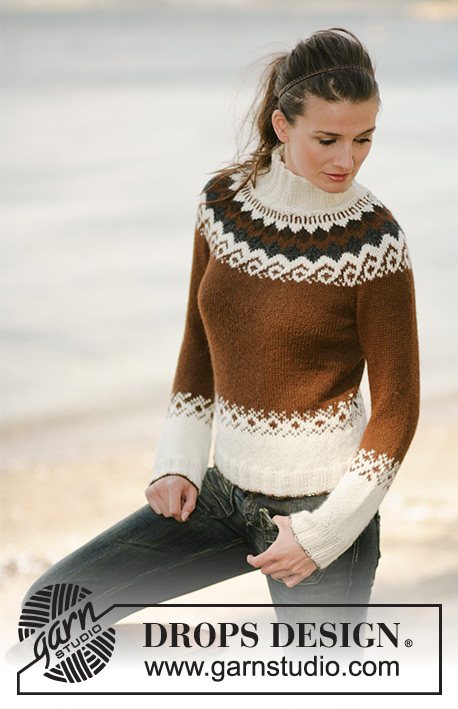 |
|||||||||||||||
DROPS Jumper in double thread Alpaca
DROPS 97-24 |
||||||||||||||||
|
Knitting tension: 18 sts x 23 rows on needles size 4.5 mm with 2 threads of Alpaca in stocking sts = 10 x 10 cm. Pattern: See diagrams M.1 & M.2. The diagram is seen from the right side. English Translations for the wording in the diagrams are given at the bottom of this pattern, and they are given in the vertical order in which they appear in the diagram. Rib: *K3, P3*, repeat from *-* Back and front piece: Knitted round on circular needle. Cast on 150-162-180-198-216 sts on circular needles size 3.5 mm with 2 threads of light brown. Change to 2 threads of off white and knit 6 cm Rib. Change to circular needle size 4.5 mm and continue in stocking sts, at the same time on the 1st row adjust the number of sts to 144-152-176-192-208. Insert a marking thread each side (= 72-76-88-96-104 sts between the marking threads). When the piece measures 10 cm knit M.1 (the arrow in diagram applies to the sleeve only). Continue in stocking sts and light brown. At the same time when the piece measures 18 cm inc 1 st each side of the marking threads, repeat on every 7-7-8-8-9 cm 2 more times = 156-164-188-204-220 sts. When the piece measures 34-35-36-37-38 cm knit the next round as follows: Cast off 4 sts for the armholes, knit 70-74-86-94-102 sts (= front piece), cast off 8 sts for the armhole, knit 70-74-86-94-102 sts (= back piece) and finally cast off 4 more sts for the armhole. Put the piece aside and knit the sleeves. Sleeve: Knitted round on double pointed needles. Cast on 42-48-54-54-60 sts on double pointed needles size 3.5 mm with 2 threads of light brown. Change to 2 threads of off white and knit in 6 cm Rib. Change to double pointed needles size 4.5 mm and continue in stocking sts, at the same time on the 1st round adjust the number of sts to 42-45-49-51-55. When the piece measures 8-10-10-10-9 cm inc 2 sts underneath the sleeve on every 4-3.5-3.5-3.5-3.5 cm a total of 10 times = 62-65-69-71-75 sts. At the same time when the piece measures 15 cm knit M.1 - make sure the repeat is placed at the top of the sleeve (see the arrow in the diagram which marks the centre), include the inc sts in the pattern – make sure that the pattern in not displaced! When the piece measures 46-45-45-45-44 cm cast off 8 sts underneath the sleeve = 54-57-61-63-67 sts. Put the piece aside and knit another sleeve. Yoke: Insert the sleeves on the same circular needle as the front and back piece at the place where you cast off for the armholes = 248-262-294-314-338 sts. Insert a marking thread in all the transitions between sleeves, back and front pieces = 4 marking threads. Continue in stocking sts at the same time dec for raglan. Knit 2-3-2-1-2 rounds before beginning the dec. Dec on both sides of each marking thread = 8 dec per round. Dec before the marking thread as follows: K2 tog. Dec as follows after the marking thread: Slip a st as if to knit, K1, psso. Dec on every 4th row 0-0-4-5-5 times, then on every other row 4-4-0-0-0 times = 216-230-262-274-298 sts. Knit 3-4-2-1-2 rounds with light brown at the same time on the 1st round adjust the number of sts evenly to 216-225-261-270-292. Then knit and dec according to M.2. After the last dec. = 120-125-145-150-165 sts on needle. Then knit 1 round in off white at the same time dec the number of sts evenly on round to 102-108-108-114-120. Change to double pointed needles size 3.5 mm and knit 12 cm Rib in off, then cast off in Rib. Assembly: Sew the openings underneath the arms. |
||||||||||||||||
Diagram explanations |
||||||||||||||||
|
||||||||||||||||
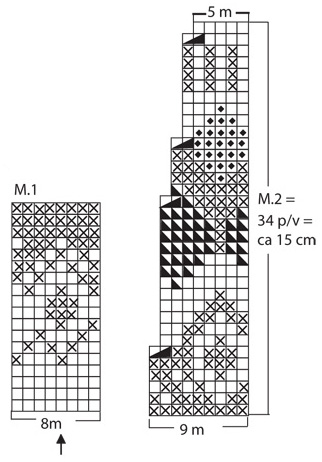 |
||||||||||||||||
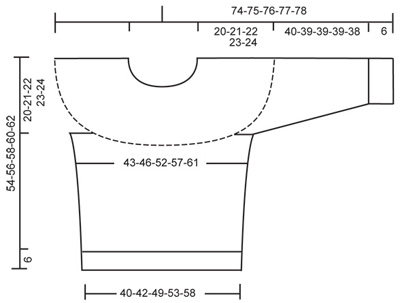 |
||||||||||||||||
Have you finished this pattern?Tag your pictures with #dropspattern or submit them to the #dropsfan gallery. Do you need help with this pattern?You'll find 19 tutorial videos, a Comments/Questions area and more by visiting the pattern on garnstudio.com. © 1982-2025 DROPS Design A/S. We reserve all rights. This document, including all its sub-sections, has copyrights. Read more about what you can do with our patterns at the bottom of each pattern on our site. |
||||||||||||||||








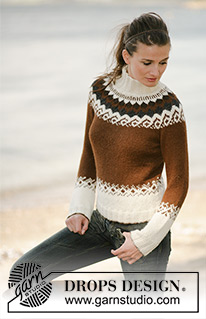

















































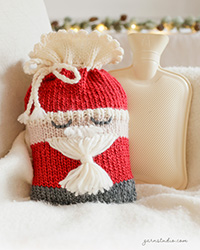
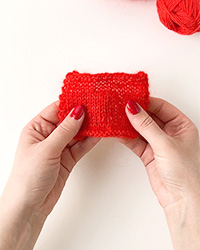
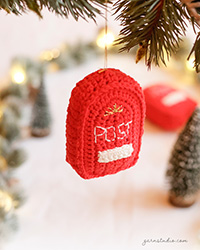
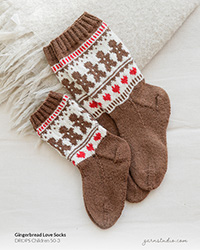
Post a comment to pattern DROPS 97-24
We would love to hear what you have to say about this pattern!
If you want to leave a question, please make sure you select the correct category in the form below, to speed up the answering process. Required fields are marked *.